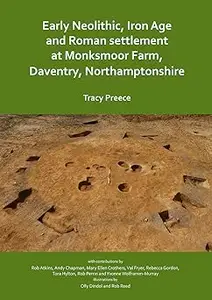
Free Download Tracy Preece, "Early Neolithic, Iron Age and Roman settlement at Monksmoor Farm, Daventry, Northamptonshire"
English | ISBN: 1789692105 | 2019 | 94 pages | PDF | 22 MB
Includes contributions from Rob Atkins, Andy Chapman, Mary Ellen Crothers, Val Fryer, Rebecca Gordon, Tora Hylton, Rob Perrin and Yvonne Wolframm-Murray; illustrations by Olly Dindol and Rob Reed. MOLA (Museum of London Archaeology) has undertaken archaeological work at Monksmoor Farm on the north-eastern edge of Daventry in six different areas. The earliest archaeological features lay in Area 6 at the southern end of the development area, where two pits were radiocarbon dated to the early Neolithic. They contained a moderate assemblage of worked flints along with sherds of early Neolithic pottery. In the middle Iron Age a settlement was established in the same location comprising a roundhouse and several enclosures. Two other contemporary settlements are thought to have originated in the late Iron Age/ early 1st century BC and were identified in Areas 1 and 2 between c0.2km and 0.5km apart and 500m to the north of Area 6. Area 1 contained evidence for a cluster of eight roundhouses with associated enclosures clearly showing sequential activity, while in Area 2, a large ditched enclosure defined as a Wootton Hill type, within which another roundhouse was present. It is possible that the Wootton Hill type enclosure in particular may have a slighter earlier origin than the limited pottery assemblage suggests. Sparse early Roman features were also found in Areas 3, 4 and 5. This settlement continued in use through the later 1st to 2nd century AD. During the early Roman period the settlement in Area 6 was greatly expanded with large rectilinear ditched enclosures along with smaller enclosures and paddocks being established on either side of a routeway indicating movement of livestock was important.
Read more
Code:
Bitte
Anmelden
oder
Registrieren
um Code Inhalt zu sehen!